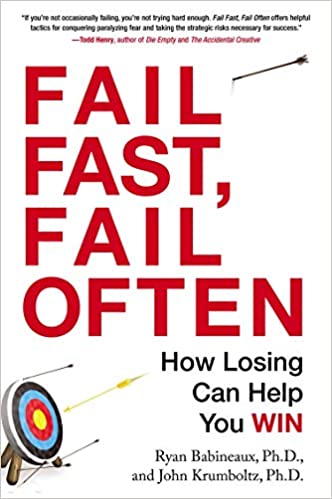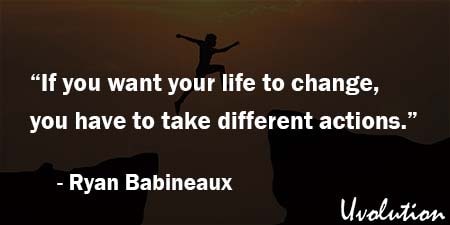Fail Fast Fail Often by Ryan Babineaux
The Book in 1 Sentences
Fail Fast, Fail Often: How Losing Can Help You Win
“The point of this book is to help you take action in your life. You might think of it as ‘Action 101’ because we teach the basics of getting going and making things happen, even though you may feel apprehensive, unprepared, or afraid of failure."
5 BIG Ideas
1. People who are happy and successful spend less time planning and more time acting.
2. “Feeling afraid or unprepared is a sign of being in the space for optimal growth.”
3. Successful people take action as quickly as possible.
4. Stop worrying about your difficult goals and focus instead on finding one small thing to do.
5. “It is natural to feel uncertain, unmotivated, or fearful when facing new challenges. But negative feelings shouldn’t stop you.”
Fail Fast, Fail Often Summary
1. Positive Moments
“Your great-uncle was a crazy inventor, and his proudest accomplishment was the creation of a wrist-worn gadget he called the fun-meter. It records a measure of the degree of enjoyment you are experiencing—how enthusiastic, vital, curious, and appreciative you are feeling.
It rates enjoyment on a scale of one to ten, with one being down-in-the-dumps and ten being happy-as-can-be. The stipulations of your uncle’s will are the following: You are to wear the fun-meter at all times.
Each day the fun-meter will take the highest enjoyment reading for the day and wirelessly transmit it to the estate attorney’s office. If the reading never falls below a value of seven over the course of the next year, then you will receive the $100 million. But if on any day the high for the day falls below seven, then you will receive nothing.
Let’s say you decide to take on the challenge of wearing the fun-meter. Right away you are going to have to live life like it really matters. You can’t let a single day pass without finding time to have at least a few moments of unadulterated joy. So here’s the question: What action would you take on the first day?”
That’s an exciting exercise.
To get the $100 million, you need to wear a fun-meter and register at least one “7” a day for the year.
That’s all about creating positive moments of genuine happiness, having fun, enthusiasm and engagement.
Can you live life like it really matters? What action would you take on the first day?
Need some help to get you over that “7” threshold? 🙂
Here’s an exercise that will help boost your happiness “Recall how energizing and rewarding it can be to really connect with somebody, sharing a flow of thoughts and feelings with ease.
As your day unfolds, seek out at least three opportunities to connect with others like this, with warmth, respect, and goodwill. Opportunities may spring up at home, at work, in your neighborhood, or out in your community.
Wherever you are, open toward others, freely offering your attention, creating a sense of safety, through eye contact, conversation, or, when appropriate, touch. Share your own lighthearted thoughts and feelings, and stay present as the other person shares theirs.
Afterward, lightly reflect on whether that interchange led you to feel the oneness of positivity resonance, even to a small degree. Creating the intention to seek out and create more micro-moments of loving connection can be another tool for elevating your health and well-being.”
Now you’re ready to go… 🙂
2. Successful People Take Action as Quickly as Possible
“We like this story because it points out an important principle: successful people take action as quickly as possible, even though they may perform badly. Instead of trying to avoid making mistakes and failing, they actively seek opportunities where they can learn quickly.
They understand that feeling afraid or unprepared is a sign of being in the space for optimal growth and is all the more reason to press ahead.
In contrast, when unsuccessful people feel unprepared or afraid, they interpret it as a sign that it is time to stop, readdress their plans, question their motives, or spend more time preparing and planning.
Let us ask you some questions:
When was the last time you accomplished something that you were really proud of?
How did you feel in the time before you reached this accomplishment? Was it comfortable? Easy?
Did you have to do things that pushed you beyond your abilities?
Did you make mistakes and mess up?
If you are like most people, you will probably find that the times in your life when you grew and accomplished the most are also the times when you made the most mistakes and blunders and had to overcome the greatest obstacles.”
That’s true!
When you feel afraid or unprepared, that means it’s time to grow…
Just take BOLD actions and go for whatever you’re afraid of! NOW is always the right time…
And really think about the last time you accomplished something that you were really proud of… I’m sure you were feeling terrible before going for it! (just like me) 🙂
3. Be Bad First
“What do innovators like Chris Rock, Howard Schultz, and Ed Catmull have in common? They are willing to fail time and time again in order to get their bearings, move forward, and learn.
Successful people understand that the best way to learn about something and get good at it is to fail at it as fast as they can. Since every significant accomplishment is preceded by flops, bad ideas, false starts, and failed efforts, these people are willing to fail as quickly and as often as possible to get it out of the way.
Instead of studying, preparing, and delaying so as to avoid making mistakes, they find ways to immediately take action, create, or do something even though they know their efforts will fall short of perfection (or even minimal competency).
Since success is usually preceded by bumbling starts and botched efforts, you can think about anything you would like to succeed at in terms of how you must first be bad at it. You can put it in this form: If I want to succeed at __________, I must first be bad at __________.”
That’s amazing!
A LOT of us seek perfectionism before stepping forward and make something… Just thinking “I should be really GOOD”!
And that for sure makes us overwhelmed and may even paralyze us!
Ok, let’s start using this formula “If I want to succeed at __________, I must first be bad at __________.” For me, this is my first website, and sure I want to succeed and make it as GOOD as possible. But I must first be bad at web design, writing and these kind of things 🙂 … I’m trying to “fail fast and fail often” to finally get what I want.
And always remember that the best way to learn about something and get good at it is to fail at it as fast as they can.
So, be bad first! It’s OK 🙂
4. Small Wins
“It can be difficult to get started on big projects such as changing your career path, reorganizing your office, or establishing a healthier lifestyle.
When you find yourself becoming paralyzed because you are unsure of how to proceed, it is time to stop worrying about your difficult goals and to focus instead on finding one small thing to do.
No matter how confused or chaotic your life may be, you can always find one positive step to take. By taking that first step, you get things moving and open yourself to new opportunities, making it easier to take the next step.
So what next step would you like to take? It can be anything that will allow you to learn, explore, or make progress at something that is important to you.
The point is to get moving and make things happen, not to strive for a significant accomplishment. The smaller and easier your action step, the better! One of the hallmarks of the small wins approach is that you often don’t know where your actions will lead.
So don’t worry about trying to follow a linear path. Just have fun taking lots of little steps and enjoy the surprise of being led to unexpected places.”
Do you have BIG goals? Overwhelmed and don’t know where to start?
Just find the smallest and easiest step you can do right now, and DO IT!
These small wins will make you feel better and keeps you going, Got it?!
Ryan and John tell us that John Steinbeck, Nobel Prize-winning author of Grapes of Wrath, once said: “When I face the desolate impossibility of writing 500 pages, a sick sense of failure falls on me and I know I can never do it. Then, gradually, I write one page and then another. One day’s work is all I can permit myself to contemplate.”
Small baby steps, one step at a time, will make you accomplish more over time…
So, what’s your next micro goal? Go do it! 🙂
5. The Discomfort of Failure is Part of It
“Here you might be saying: “Well, all this talk sounds nice enough, but no matter how you spin it, it’s still no fun to fail.’
It is certainly true that no matter how positive-minded you try to be, it can be painful when things don’t work out the way you want—when your application isn’t accepted at an elite school, you don’t get the job, your artwork isn’t taken by a gallery, your business doesn’t catch on, or you find that you aren’t as talented as you hoped.
When this happens, it is going to feel disappointing. It may make you doubt your intelligence, abilities, and ideas. That’s OK. It is a short-lived pain that will go away. This is nothing compared to the fear of failure, which drains your vitality and paralyzes you from taking the actions that bring joy and meaning into your life.
It may help to accept the unpleasantness if you consider its alternative—living a stuck-in-the-rut life. ... If you want a life filled with passion and growth, then the discomfort of failure is part of it. So acknowledge your disappointment and then move beyond it.”
You know what! It’s better to temporarily feel pain than living a stuck-in-the-rut life!
I’m sure you know that people at the end of their lives rarely regret the things they did. They regret the things they didn’t do.
Mark Twain said: “Twenty years from now you will be more disappointed by the things you didn’t do than by the ones you did do. So throw off the bowlines. Sail away from the safe harbor. Catch the trade winds in your sails. Explore. Dream. Discover.”
And finally remember that: “It is natural to feel uncertain, unmotivated, or fearful when facing new challenges. But negative feelings shouldn’t stop you.
The best way to gain confidence and improve your mood is to take action, even though you’re not feeling up to it. The next time you find yourself hesitating due to your negative mood, get going anyway.
Go for a run even though you feel lethargic; invite a colleague to lunch even though you feel shy; volunteer for a project even though you doubt your abilities; or enroll in a challenging course even though you feel unprepared.
Now it’s time for you to get out there and fail as quickly as you possibly can. And then fail again.”
Ready to fail fast?! 🙂
That was my QUICK Fail Fast Fail Often summary. If you’re interested, get your copy. There is a HUGE amount of wisdom and life-changing ideas in this book, and we’ve only touched on a tiny bit of it.
Buy The Book: Fail Fast Fail Often by Ryan Babineaux

GET Blinkist 7 Days FREE Trial
3000+ Book Summaries
(Audio and Text)





